#Desilu Studios
Explore tagged Tumblr posts
Text

Desi Arnaz and Lucille Ball in 1958 at the former RKO studio lot where they met when they co-starred in the 1940 musical TOO MANY GIRLS, now it’s their joint venture, Desilu Studios. (Photos by Leonard McCombe for Life)

104 notes
·
View notes
Text
In what ways did William Shatner's portrayal of Captain James T. Kirk differ from the way the character was originally written?

You really have to look at the difference between Captain Christopher Pike (portrayed by Jeff Hunter in the first Star Trek pilot, “The Cage”) and Captain James Kirk (portrayed by William Shatner in the second Star Trek pilot, “Where No Man Has Gone Before”) to see the evolution of the Captain in Star Trek.
As originally written, the Captain of the USS Enterprise was a rather dark, tormented man who was already thinking of resigning his Starfleet commission (in the pilot episode) because he was fed-up with the demands of leadership. That was Jeff Hunter’s portrayal of Christopher Pike.
^^^ Jeff Hunter’s Captain Pike appeared as almost a reluctant commander. He was introspective and self-doubting and mostly humorless, and he didn’t want the responsibility of issuing life-or-death orders and leading others into deadly situations.
He didn’t like women on the bridge, either, except for his First Officer Number One (because she had no obvious feminine personality).
Pike was also aggressive. He barked most of his lines, he glared a lot, and he was even violently intimidating (choking a frightened and physically-frail Talosian, for example, and directly threatening to burn a hole through the alien at close range).
^^^ If looks could kill, right. No wonder the Talosians concluded that humans were "too violent and dangerous a species for our needs.”

NBC rejected the first Star Trek pilot for several reasons, including Jeff Hunter’s Christopher Pike, who was considered too intense, angry and not very likable. Gee, wonder why?
Could it be because Jeff Hunter’s controlling wife was often on the set, badgering Hunter as well as the producer and director? That probably made Hunter’s job many times more difficult, and I think it showed in his performance.
When NBC requested a second Star Trek pilot, it was decided to rewrite some characters and do away with others. For example, First Officer Number One was entirely removed from the script; Spock was promoted to First Officer as well as Science Officer; Doctor Boyce (Ship’s Physician and bartender) was also eliminated from the script and replaced with a more down-to-earth country doctor (this was Doctor Piper, who quickly evolved into Doctor McCoy); and Christopher Pike was to be rewritten as a kinder, gentler, more likable Captain.
However, there was a contractual problem, inasmuch as Jeff Hunter had signed to do only one pilot and a series (if NBC bought it)…but he didn’t sign to do two pilots and a series. Gene Roddenberry and Desilu Studios really wanted Jeff Hunter to continue working on the show, but they knew they’d have to cajole Hunter (and his overbearing wife) into signing for a second pilot.
So, Roddenberry called Jeff Hunter in for a post-rejection screening of The Cage to discuss character revisions and signing another contract for another pilot. This is where it got messy.
Desilu production head Herbert Solow was at the screening and described it best:
“In the eyes of the New York and Los Angeles television world, Star Trek was already a failure. But we knew differently and looked forward to running the completed pilot for our star, Jeff Hunter. We hoped it would convince him to do another pilot. Gene and I waited in the Desilu projection room for him to arrive. He never did. Arriving in his stead was actress Sandy Bartlett, Mrs. Jeff Hunter. We traded hellos, and I nodded to Gene. He flicked the projection booth intercom switch. ‘Let's go.’
“As the end credits rolled, and the lights came up, Jeff Hunter's wife gave us our answer: ‘This is not the kind of show Jeff wants to do, and besides, it wouldn't be good for his career. Jeff Hunter is a movie star.’ Mrs. Hunter was very polite and very firm. She said her good-byes and left, having surprisingly and swiftly removed our star from our new pilot.”
–Herb Solow, Inside Star Trek: The Real Story
So, Jeff Hunter just vanished from Star Trek. He wasn’t fired, as some claimed…he quit. Or, more precisely, his beast of a wife quit for him. Two years later (1967), after Star Trek was a success, Jeff Hunter divorced his wife.
As it happened, there was another actor invited to that same screening (quietly taking notes), and that actor was Bill Shatner, who was waiting in the wings when Jeff Hunter opted out.
Thus entered the new Captain of the Enterprise, James R. Kirk.
^^^ Yep, he was actually named James R. Kirk in his first Star Trek appearance: It says so on his tombstone in “Where No Man Has Gone Before,” the second Star Trek pilot.
Shatner’s Kirk was basically just the opposite of Hunter’s Pike. Captain Kirk was thoughtful but not deeply introspective; he was not tormented but was supremely confident and never self-doubting; he loved his ship and crew, but was willing to take life-or-death risks with both; he was perfectly comfortable with women on the bridge (or just women in general); and he could be humorous, if a little irritating.
^^^ Captain Kirk was a more likable, humorous and confident alternative to Christopher Pike.
Captain Kirk, unlike Captain Pike, was always a ready negotiator, offering an olive branch first and only turning to violence as a last resort; indeed, even in violent scenes, Kirk was typically defending himself.

In short, Shatner portrayed Kirk as a role model for kids. Shatner fully realized that Star Trek was a kids’ show, first and foremost, so he played a kid’s idea of a starship captain…and nailed it.
It became apparent from the second pilot onward that Kirk’s human warmth was a perfect balance for Spock’s icy Vulcan logic (which evolved as the first season of Star Trek progressed). Their dynamic became pure gold for the series and the movie franchise.
^^^ DeForest Kelley’s emotional and quick-tempered Doctor McCoy assumed the role of a counter-character playing against Spock, while Kirk became the reasonable middle-man between the two, and so was born the legendary trio.
By Charles Austin Miller, Investigative Journalist and Publisher.
Found at Quora:
#space opera#space western#star trek#star trek the original series#jeffrey hunter#william shatner#christopher pike#james t. kirk#star trek tos#60s sci fi#60s tv series#60s tv shows#desilu studios#gene roddenberry
15 notes
·
View notes
Text
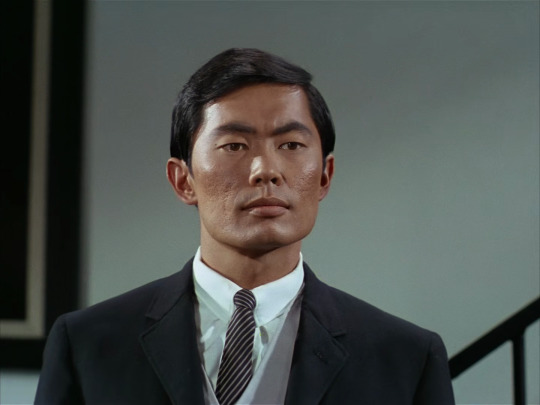
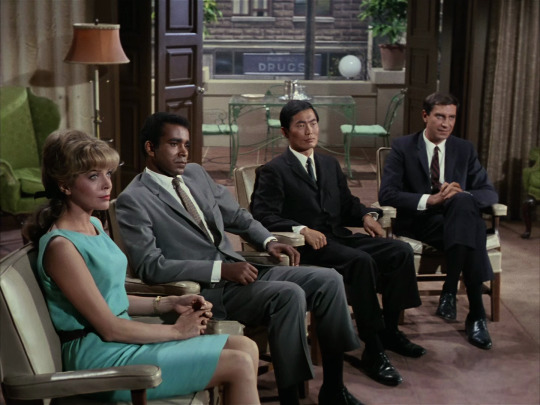




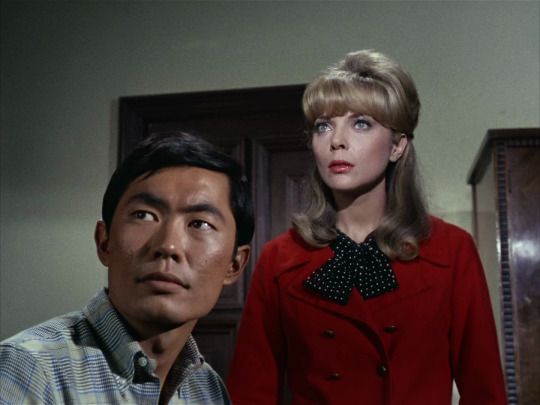
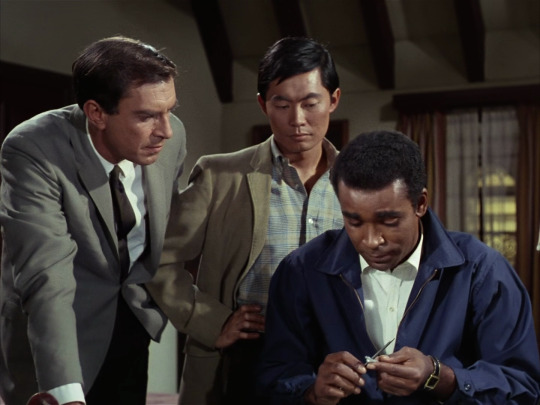
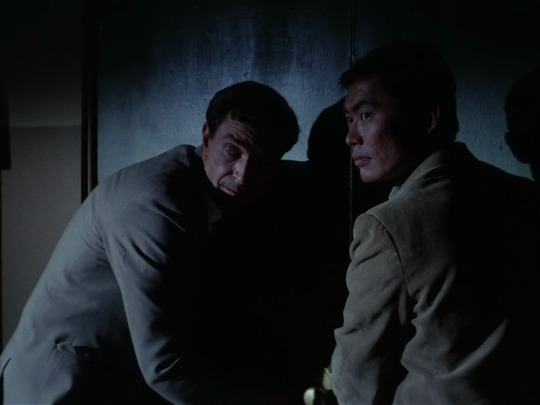
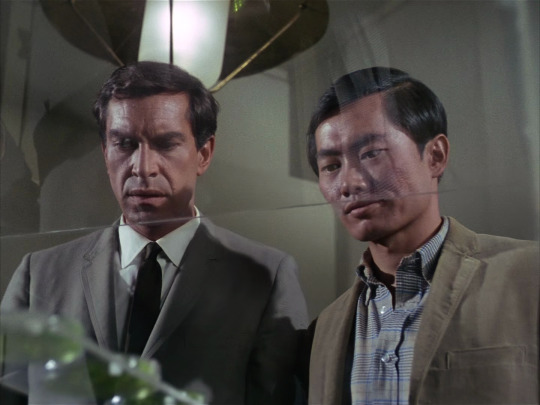

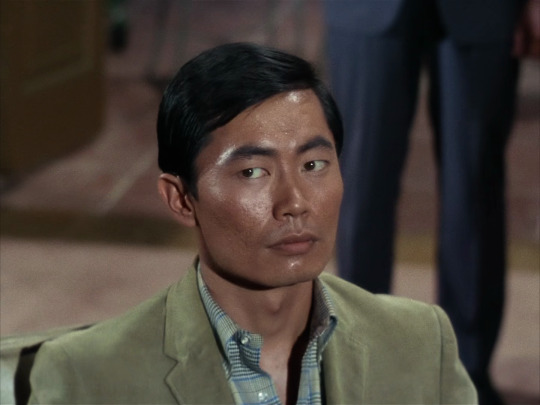
Today in the Department of Before They Were Star Trek Stars: George Takei guest stars in "The Carriers," episode 10 of the first season of Mission: Impossible (original air date November 19, 1966). Although this episode aired two months after the premiere of Star Trek, it's hard to say which was filmed first, and even though it's an edge case I'm including it because I liked it and I had a nice, clear Blu-Ray copy to screencap. So there.
Takei plays Roger Lee, a scientist and IMF agent who joins the team in infiltrating a training program for Communist spies behind the Iron Curtain and foiling a planned biowarfare attack on the United States.
Other Trek connections: Herbert F. Solow developed and produced both Star Trek and Mission: Impossible for Desilu. The framing device of the Captain's Log was his idea, and has been used in most Star Trek projects to date.

#star trek#star trek the original series#star terk tos#mission impossible#1960s tv#desilu studios#george takei#martin landau#barbara bain#greg morris#arthur hill#tv sci fi#spy tv#herbert f solow
12 notes
·
View notes
Photo

Random Photo Tuesday
Leonard Nimoy (dressed as Mr. Spock) taking a break at Desilu Studios beside his '63 Buick Riviera.
18 notes
·
View notes
Text
Lucille Ball was a powerhouse:
"Her belief in Star Trek is why we have Star Trek as it stands today. Ball was more than just a comedian and a beloved television icon, she was a savvy producer who deserved credit for her work behind the scenes, including helping to achieve Roddenberry’s vision. For this, we can all love Lucy."
https://www.startrek.com/news/how-lucille-ball-helped-star-trek-become-a-cultural-icon
theres a post that says star trek predates ship names but thats not true...
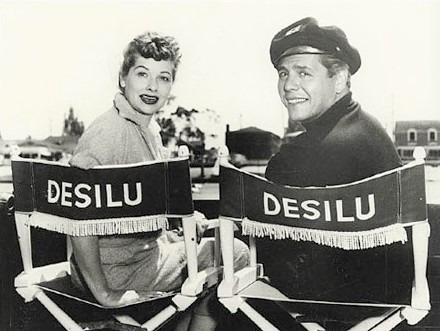
wait this makes it even better...
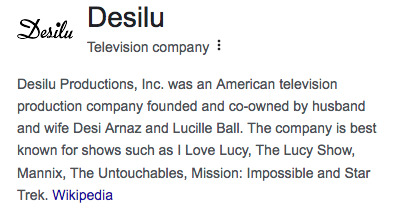
STAR TREK WAS PRODUCED BY THE SHIP NAME COMPANY?!
818 notes
·
View notes
Photo
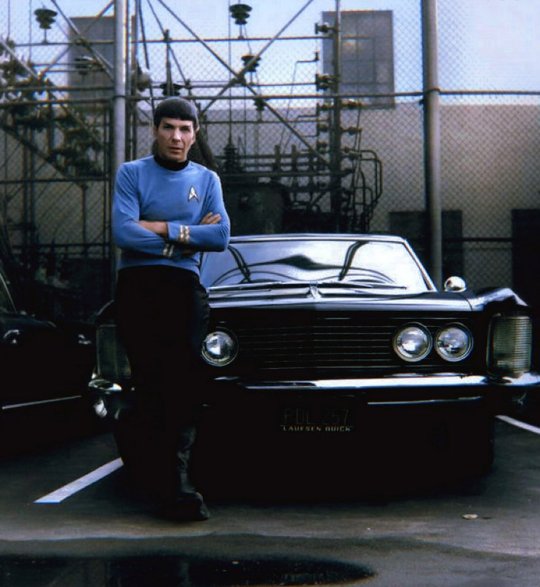
536 notes
·
View notes
Text





Desilu Cahuenga - Then versus Now
#desilu#backlot#hollywood studios#cahuenga blvd#willoughby ave#gomer pyle usmc#jim nabors#gomer pyle#the andy griffith show#frank sutton
16 notes
·
View notes
Text

Wednesday matinee Intermission pic! Behold (again) Mrs Wingate's housekeeper, Geraldine! (With the correct collar this time!) #actorslife #actor #goodspeedsummerstock #musicaltheatre #ensemble #understudy #worldpremiere

Is it "Nan," the wardrobe mistress, or is it Lucille Ball? ���� #actorslife #goodspeedsummerstock #newmusical #worldpremiere #costumes #characteractor
so the film's role of the housekeeper at falbury farm (which jane inherited from her late father) who is then Around, helping out, apparently having known the sisters at least from childhood and having fun facts about it, and going from disapproving towards the whole notion of thee performance arts to implicitly having dropped that due to supporting jane from backstage, and is basically like some older family member, is presumably supplanted by pop falbury, who could then do all that & more, makes sense. but we get An housekeeper as an ensemble part lol

Behold Mrs Wingate's housekeeper, Geraldine! 😉 #intermissionselfie #intermissionpic #newmusical #musicaltheatre #musicals
which, great time to point out the intrigue around, say, the second act one scene set at the wingate house, like, what is montgomery, fancy would-be lead actor in the show within the show, doing there at all? would love to know
#summer stock#universe in which lucille ball got her start as [name of show in this show]'s wardrobe mistress then#which reminds me i went ''oh; huh'' when looking up eddie bracken (actor who plays orville in '50 film) and learning one film he was in#was where lucille ball & desi arnaz met. was thinking the other day abt how they just didn't do tv reruns until i love lucy#and this was also b/c of the show innovating by being on film instead of kinoscope so that....smthing smthing like#to get the nationwide scheduling they wanted One version would've had to be a second generation copy film of what was filmed?#and if it was the lower kinoscope quality in the first place then the west coast's nonLive aired copy of it would be too shitty lol. i Thin#let's all read the i love lucy &/or perhaps desilu productions &/or lucille ball wikipedia pages#but also before that it was like ''why would people want to watch something they'd seen before'' which Lol. Lmao.#but it's a sentiment that also lines up w/the forever resurfacing twitter qrt memes like name 5 films you've seen more than three times :)#like lol binch. that's abt the Minimum for if i liked something i've seen at all....#or ppl like ''lol umm whoah calm down zanyface'' over how Immediately you wanna see something again. again i say: binch;#but whereas now reruns aren't synonymous with Thrilling they're neither deemed unwatchable nor are unwatched; obviously#yet the assumption was just like nobody's gonna do that wild shit (sit down & enjoy something they've Already Seen)#and of course i love lucy being especially popular....Been in reruns ever since....#yeah thought of it b/c i was watching the matt baume video essay abt norman lear & that incredible influence over All Of Tv as well#and that ''all in the family'' didn't start catching on & gaining more significant popularity until the first season was in reruns#ok no wait i'm doing research. i love lucy was Filmed in the west coast & the kinoscope technique is itself that [filming a tv] copy#idk how the scheduling played into it but hence using higher quality Film instead of any kinoscoping at all. pioneering using 3 Cameras#ok yeah i thought so re: i love lucy being the first show also filmed w/Live Studio Audience. & laugh Tracks are oft its reused recordings#and the whole like ''an interracial relationship....ppl won't like that'' so they just do it as a vaudeville act first to show that they do#only recently learning Pregnancy was considered Inappropriate b/c it Implied Having Had Sex lsdfj like the stork is for Our sakes thanks...#but anyways also knew that having her character be pregnant & have a baby was also Bold(tm) & they couldn't say ''pregnant''#''enceinte'' episode title....anyways great quote here from this pbs article i'm looking at. she understood that [tv] could have the#excitment of vaudeville; the wonder of the movies; & come directly into people's homes with the intimacy of the radio
6 notes
·
View notes
Text
Lucille Ball gave us Star Trek
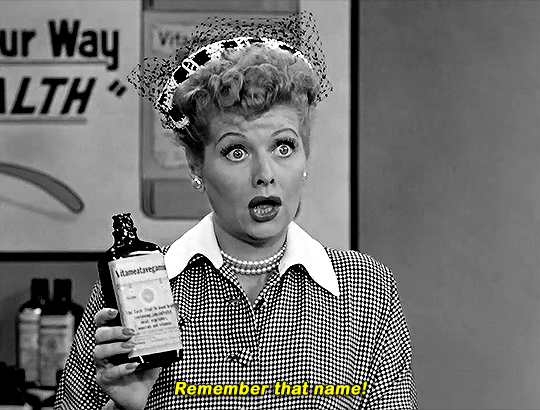
Just in case y'all don't know, Gene Roddenberry wasn't having the easiest time getting his space western launched. He pitched it to Desilu (Lucille Ball and Desi Arnaz's production company) and Lucy gave it the green light. She stood by it through one failed (but now beloved) pilot and helped to get it off the ground.
#star trek#star trek history#i love lucy#desilu#lucille ball#desi arnaz#star trek the original series#star trek the next generation#star trek enterprise#star trek voyager#star trek discovery#star trek strange new worlds#star trek deep space nine#the more you know
143 notes
·
View notes
Text
"There are many reasons why Star Trek was canceled by NBC in 1969 beyond simple ratings. If anything, the series was troubled from the start. First, the show's original pilot failed, but Lucille Ball of Desilu Productions agreed to give Roddenberry another shot. Second, Star Trek was an expensive series to produce despite being co-financed by NBC. Third, Art director Matt Jefferies, production designers and visual effects personnel were asked to do the impossible each week. Still, despite these setbacks, Star Trek spawned a universe of more than a dozen series, with new shows in production almost 60 years later. So, how did this misbegotten science fiction version of Wagon Train beat the odds?"
-Joshua M. Patton
Read more of his interesting article on the legacy of Star Trek: TOS after its cancellation on the following link:
#space opera#space western#star trek tos#60s sci fi#star trek#60s tv shows#gene roddenberry#desilu studios
2 notes
·
View notes
Text

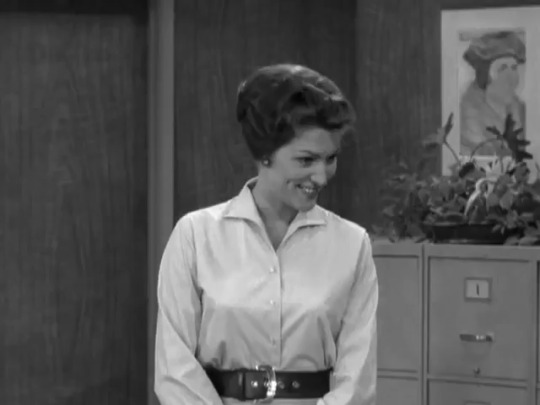
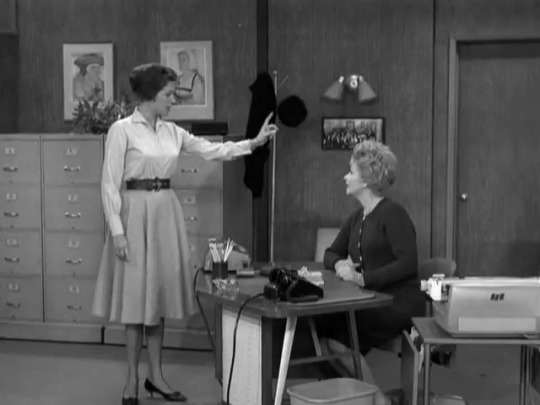

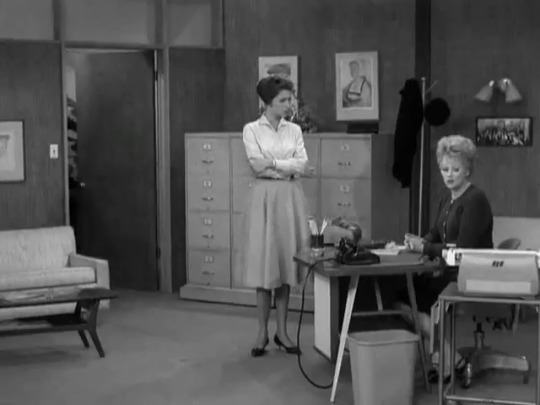
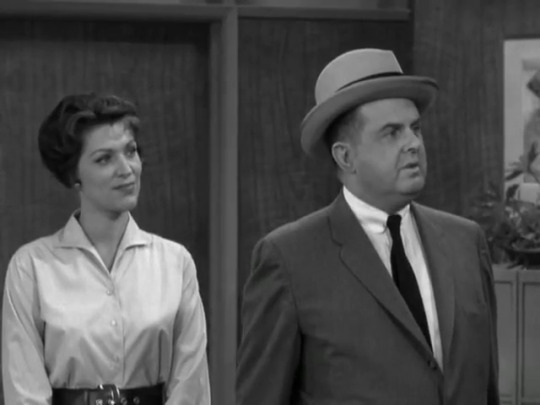

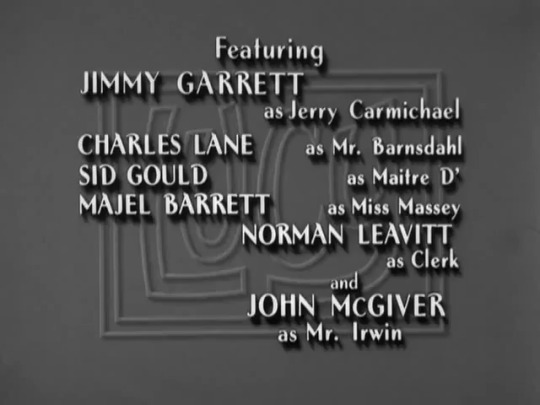
Today in the Department of Before They Were Star Trek Stars, Majel Barrett guest stars in "Lucy is a Kangaroo for a Day," episode 7 of the first season of The Lucy Show (original air date November 12, 1962). Barrett plays Lucy's supervisor at a temp job.
Other Trek connections: Star Trek was produced by Lucy's Desilu Studios, and she was an early and passionate advocate for the show when the networks didn't think it was a viable concept.


#star trek tos#star trek the original series#the lucy show#1960s tv#tv sci fi#tv sitcom#majel barrett#lucille ball#charles lane#desilu#star trek
29 notes
·
View notes
Text



Harry Culver, who founded Culver City, CA opened the Culver Hotel (originally Hotel Hunt), on September 4, 1924.
Thomas Ince, Hal Roach, Cecil B. DeMille, David O. Selznick, RKO, Desilu and Culver Studios as well as MGM were its neighbors.
16 notes
·
View notes
Photo

52 years ago today, April 4, 1971, the final episode of Hogan's Heroes aired. It ran for 168 episodes from September 17, 1965, to April 4, 1971, on the CBS network. Bob Crane starred as Colonel Robert E. Hogan, coordinating an international crew of Allied prisoners running a Special Operations group from the camp. Werner Klemperer played Colonel Wilhelm Klink, the incompetent commandant of the camp, and John Banner was the inept sergeant-of-the-guard, Hans Schultz.
Hogan's Heroes won two Emmy Awards out of twelve nominations. Both wins were for Werner Klemperer as Outstanding Performance by an Actor in a Supporting Role in a Comedy, in 1968 and 1969. Klemperer received nominations in the same category in 1966, 1967 and 1970. The series' other nominations were for Outstanding Comedy Series in 1966, 1967 and 1968; Bob Crane for Outstanding Continued Performance by an Actor in a Leading Role in a Comedy Series in 1966 and 1967; Nita Talbot for Outstanding Performance by an Actress in a Supporting Role in a Comedy in 1968; and Gordon Avil for cinematography in 1968.In December 2005, the series was listed at number 100 as part of the "Top 100 Most Unexpected Moments in TV History" by TV Guide and TV Land. The show was described as an "unlikely POW camp comedy.
Hogan's Heroes was filmed in two locations. Indoor sets were housed at Desilu Studios, later renamed as Paramount Studios for Season Four and then Cinema General Studios for Seasons Five and Six. Outdoor scenes were filmed on the 40 Acres Backlot. 40 Acres was in Culver City, in the Los Angeles metropolitan area. The studios for indoor scenes were both located in Hollywood, CA. Undoubtedly, one of the most original and curious aspects was to create the effect that there was always a snowy winter, something unusual in warm Southern California, but normal in the German winter. The actors had to wear warm clothes and frequently act like they were cold, even though it was warm for much of the year and usually hot during summer.
Although it was never snowing on the film set and the weather was apparently sunny, there was snow on the ground and building roofs, and frost on the windows. The set designers created the illusion of snow two ways: the snow during the first several seasons was made out of salt. By the fourth season, the show’s producers found a more permanent solution and lower cost, using white paint to give the illusion of snow. By the sixth and final season – with a smaller budget – most of the snow shown on the set was made out of paint.
After the series ended in 1971, the set remained standing until it was destroyed in 1974 while the final scene of Ilsa, She Wolf of the SS was filmed
The actors who played the four major German roles—Werner Klemperer (Klink), John Banner (Schultz), Leon Askin (General Burkhalter), and Howard Caine (Major Hochstetter)—were all Jewish. Furthermore, Klemperer, Banner, and Askin had all fled the Nazis during World War II (Caine, whose birth name was Cohen, was an American). Further, Robert Clary, a French Jew who played LeBeau, spent three years in a concentration camp (with an identity tattoo from the camp on his arm, "A-5714"); his parents and other family members were killed there. Likewise, Banner had been held in a (pre-war) concentration camp and his family was killed during the war. Askin was also in a pre-war French internment camp and his parents were killed at Treblinka. Other Jewish actors, including Harold Gould and Harold J. Stone, made multiple appearances playing German generals.
As a teenager, Klemperer, the son of conductor Otto Klemperer, fled Hitler's Germany with his family in 1933. During the show's production, he insisted that Hogan always win against his Nazi captors, or else he would not take the part of Klink. He defended his role by claiming, "I am an actor. If I can play Richard III, I can play a Nazi." Banner attempted to sum up the paradox of his role by saying, "Who can play Nazis better than us Jews?" Klemperer, Banner, Caine, Gould, and Askin had all spent the real Second World War serving in the U.S. Armed Forces—Banner and Askin in the U.S. Army Air Corps, Caine in the U.S. Navy, Gould with the U.S. Army, and Klemperer in a U.S. Army Entertainment Unit. But the sitcom was not the first time Klemperer had played a Nazi: in 1961, he starred as the title character in the serious drama Operation Eichmann, which also featured Banner in a supporting role. Ruta Lee, Theodore Marcuse, and Oscar Beregi, Jr. also appeared in the film, each of whom went on to make several guest appearances on Hogan’s Heroes.
https://www.facebook.com/Retrovision
134 notes
·
View notes
Photo

Character Actress
Adele Mara (born Adelaida Delgado; April 28, 1923 – May 7, 2010) Actress, singer, and dancer, who appeared in films during the 1940s and 1950s and on television in the 1950s and 1960s.
In 1955 Mara appeared as Sarita on the TV western Cheyenne in the episode "Border Showdown." In 1958, Mara played Maria Costa in the Bat Masterson episode "Double Showdown" with Gene Barry. In 1961, Mara appeared as a nurse with Cesar Romero on CBS's The Red Skelton Show in a sketch titled "Deadeye and The Alamo". About this time, she guest-starred on the NBC Western series The Tall Man with Clu Gulager, as well as three episodes of Maverick (one with James Garner and Jack Kelly and two with only Kelly), and episodes of Laramie, Tales of Wells Fargo with Dale Robertson and The Life and Legend of Wyatt Earp with Hugh O'Brien. She also appeared in the Alfred Hitchcock Hour episode "House Guest" in 1962.
Her other television credits include:
The Lone Wolf
Adventures of the Falcon
Big Town
Soldiers of Fortune
Studio 57
The Millionaire
The Adventures of Rin Tin Tin
Conflict
Meet McGraw
The Magical World of Disney
Casey Jones
Tales of Wells Fargo
Westinghouse Desilu Playhouse
77 Sunset Strip
Markham
Stagecoach West
Dante
The Red Skelton Hour
Bringing Up Buddy
Lockup
Bachelor Father
Thriller
The Tall Man
Cool Million
Wheels
(Wikipedia)
7 notes
·
View notes
Text
We're going to get our damned show back.
Friends, besties, siblings in christ, we're going to do it because Star Trek. All these fans, these women, in 1966 or 67 without internet, without conventions, how did it even happen? Over coffee, they said "hey, do you like this...TV show?" When they met in the grocery store. Maybe even on a trip, they saw some person, and they knew: "do you watch this TV show?" And they wrote letters and made phone calls. And Lucille motherfucking Ball at Desilu said "Yep. Keep it up." And that is why there are 3 years of Star Trek. 79 fucking episodes.
We have these powers they never dreamt of. Ways to connect. Ways to annoy. We don't have Lucy Ball anymore, but fellow babies, we've got spunk. (And I don't hate spunk.) (My timeline is off. But not actually false?)


12 notes
·
View notes
